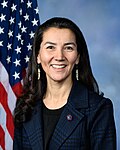| Alaska's at-large congressional district | |
|---|---|
 | |
| Representative | |
| Area | 665,384.04 [1] sq mi (1,723,336.8 km2) |
| Distribution |
|
| Population (2024) | 740,133 [3] |
| Median household income | $95,665 [4] |
| Ethnicity |
|
| Cook PVI | R+6 [5] |
Since becoming a U.S. state in 1959, Alaska has been entitled to one member in the United States House of Representatives. The representative is elected at-large, because the state has only one congressional district, encompassing its entire territory. By area, Alaska's congressional district is the largest congressional district in the United States and the third-largest electoral district represented by a single member in the world, exceeded by the Yakutsk district in Russia and Nunavut in Canada.
Contents
- History
- Voter registration
- Recent statewide election results
- List of members representing the district
- Electoral history
- 1958 to 2010
- 2012
- 2014
- 2016
- 2018
- 2020
- 2022 special
- 2022
- 2024
- Notes
- References
On August 31, 2022, Democrat Mary Peltola defeated Republican former governor Sarah Palin in the special election to replace Don Young, who died on March 18 of the same year, was the longest serving Republican in the history of the House, and was the most notable person to represent the district. Peltola became the first Democrat elected to the House of Representatives from Alaska since 1972, and the first Alaska Native in history to be elected to the United States House of Representatives. Peltola was defeated by Nick Begich III in 2024.
It has a partisan lean of R+6. [5]





